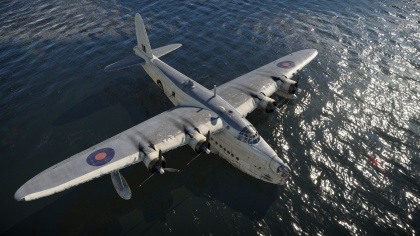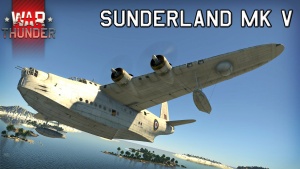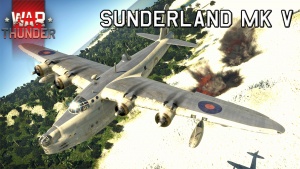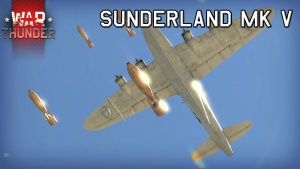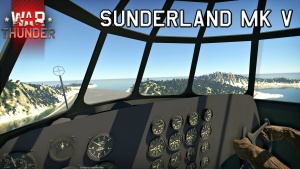Sunderland Mk V
Contents
| This page is about the British bomber Sunderland Mk V. For the other version, see Sunderland Mk IIIa. |
Description
The Sunderland Mk V is a rank British bomber
with a battle rating of (AB), (RB), and (SB). It was introduced in Update 1.65 "Way of the Samurai".
General info
Flight Performance
The Sunderland Mk V is rather finicky in the air. Handling is not all that bad, turn time is about 20-25 seconds spaded with flaps. However, the wings can only take 3-4Gs before they snap off. Due to the low rip speed, this means you can potentially rip your wings when flying a spaded aircraft at top speed.
If there is no water available to land in, it will be necessary to belly land on the airfields. If so, take care to not let the pontoons touch the ground. However, after descending all the way for the landing, it will be necessary to continue the fight at a low altitude due to the Sunderland's atrocious climb rate forbidding any chance of reaching back to optimal bombing altitude in a timely manner.
| Characteristics | Max Speed (km/h at 4,267 m) |
Max altitude (metres) |
Turn time (seconds) |
Rate of climb (metres/second) |
Take-off run (metres) | |||
|---|---|---|---|---|---|---|---|---|
| AB | RB | AB | RB | AB | RB | |||
| Stock | 384 | 377 | 35.8 | 36.6 | 5.8 | 5.8 | 740 | |
| Upgraded | 420 | 401 | 34.2 | 35.0 | 10.2 | 7.8 | ||
Details
| Features | ||||
|---|---|---|---|---|
| Combat flaps | Take-off flaps | Landing flaps | Air brakes | Arrestor gear |
| ✓ | ✓ | ✓ | X | X |
| Limits | ||||||
|---|---|---|---|---|---|---|
| Wings (km/h) | Gear (km/h) | Flaps (km/h) | Max Static G | |||
| Combat | Take-off | Landing | + | - | ||
| 520 | 232 | 213 | ~3 | ~2 | ||
| Optimal velocities (km/h) | |||
|---|---|---|---|
| Ailerons | Rudder | Elevators | Radiator |
| < 350 | < 350 | < 250 | > 312 |
| Compressor (RB/SB) | ||
|---|---|---|
| Setting 1 | ||
| Optimal altitude | 100% Engine power | WEP Engine power |
| 1,860 m | 1,100 hp | 1,199 hp |
| Setting 2 | ||
| Optimal altitude | 100% Engine power | WEP Engine power |
| 3,810 m | 1,000 hp | 1,090 hp |
Survivability and armour
There is no armour protection on this aircraft.
Armaments
Offensive armament
The Sunderland Mk V is armed with:
- 4 x 7.7 mm Browning .303 machine guns, nose-mounted (500 rpg = 2,000 total)
Suspended armament
The Sunderland Mk V can be outfitted with the following ordnance:
- 8 x 250 lb G.P. 250 lb Mk.IV bombs (2,000 lb total)
- 4 x 500 lb G.P. 500 lb Mk.IV bombs (2,000 lb total)
Defensive armament
The Sunderland Mk V is defended by:
- 1 x 12.7 mm Browning M2 machine gun, 2 x beam turrets (500 rpg)
- 2 x 7.7 mm Browning .303 machine guns, nose turret (1,000 rpg = 2,000 total)
- 2 x 7.7 mm Browning .303 machine guns, dorsal turret (500 rpg = 1,000 total)
- 4 x 7.7 mm Browning .303 machine guns, tail turret (1,000 rpg = 4,000 total)
- 1 x 7.7 mm Vickers K machine gun, 2 x beam turrets (600 rpg)
Usage in battles
After unloading your ordnance, it's best to return to base (or wait for reload in arcade battles) and get another load. In RB/SB, taking note from the "Flight Performance" section, land appropriately and continue the fight at a lower altitude to get back quickly for another bomb drop.
At this low altitude, and with some degree of luck, the Sunderland can be used as a "gunship" fighter. It's possible to gunship manoeuvre into a furball and shoot down a plane or two. Against other bombers, attempting the "gunship" method is possible, however you must be careful of defensive weapons on the enemy bomber. The best bet is to fly just below the enemy fighter or side by side, as there are no bombers at this battle rating which have this kind of armament and the Sunderland's survivability against rifle calibre is exceptional. The forward MGs can be used, but it isn’t as effective as the other turrets. The side of the aircraft is where all the main firepower is located. Knowing this, keeping your enemy in the top and rear hemisphere is advisable for maximum guns on target while being shielded from most defensive weapons.
Manual Engine Control
| MEC elements | ||||||
|---|---|---|---|---|---|---|
| Mixer | Pitch | Radiator | Supercharger | Turbocharger | ||
| Oil | Water | Type | ||||
| Controllable | Controllable Not auto controlled |
Controllable Not auto controlled |
Controllable Not auto controlled |
Separate | Controllable 2 gears |
Not controllable |
Modules
| Tier | Flight performance | Survivability | Weaponry | ||
|---|---|---|---|---|---|
| I | Fuselage repair | Radiator | Offensive 7 mm | HMBC mk.2 | |
| II | Compressor | Airframe | New 7 mm MGs | ||
| III | Wings repair | Engine | Turret 7 mm | Turret 12 mm | |
| IV | Engine injection | Cover | New 7 mm MGs (turret) | New 12 mm MGs (turret) | |
Pros and cons
Pros:
- It has many turrets, equal or more effective than even the higher rank Wellingtons, Stirlings and Lancasters
- Has 4 x offensive 7.7 mm machine guns
- Its fuselage can soak up a lot of damage, especially from low calibre machine guns
- Can land both on land (belly slide) and in the water (not on an aircraft carrier)
- Great turret coverage, especially from the front, side, top and back of the plane
- Has .50 calibre on the side which packs a punch and can obliterate enemy fighters if they hit
- Turns rather well for a four-engined bomber
Cons:
- Small bomb load
- Handles like a flying train (A.K.A. not very well)
- Due to the lack of a bomb bay, bombs are slid out from the hatches on the side of the aircraft which can make them hard to aim
- The .50 calibre only cover the side of the aircraft, making them difficult to use effectively
- No ventral turret coverage, a smart fighter will attack you from below
- No armour. The crew are vulnerable. A few good hits on the cockpit and you're going down
- Wooden fuselage means that you will catch fire easily
- Slow, even biplanes can catch you
- Does not dive well. Escaping from an enemy aircraft is difficult
History
The Short S.25 Sunderland is a British designed & built flying boat, designed primarily to fulfil the role of a patrol bomber, the Sunderland was used primarily by the RAF, but also saw use with the French Navy, RAAF & SAAF just to name a few. The Mark V version of the Sunderland was initially developed due to concerns that the aircraft was underpowered, due to this the Bristol Pegasus engines used on previous models were replaced by Pratt & Whitney R-1830 Twin Wasp (S3C4-G) engines, these new engines offered a considerable power increase while also not causing any reductions in range or flight time, a particular benefit of the new power plant was that the Mark V could remain airborne after 2 of its 4 engines failed, this greatly improved the aircraft's survivability in comparison to earlier versions. A total of 155 Mark V airframes were produced with an additional 33 earlier Mark III's converted to Mark V standard with the updated engines.
The Mark V also featured a new centimetric ASV Mark VI C radar, this is an updated version of the air to surface radar that was also featured on later production Mark III airframes and is especially noticeable by the antenna on the underside of the wings just outboard of the floats. This radars was primarily used in the aircraft's coastal command role for detecting enemy ships.
Media
Excellent additions to the article would be video guides, screenshots from the game, and photos.
See also
Links to the articles on the War Thunder Wiki that you think will be useful for the reader, for example:
- reference to the series of the aircraft;
- links to approximate analogues of other nations and research trees.
External links
Paste links to sources and external resources, such as:
- topic on the official game forum;
- encyclopedia page on the aircraft;
- other literature.
| Short Brothers plc | |
|---|---|
| Bombers | Stirling B Mk I · Stirling B Mk III · Sunderland Mk IIIa · Sunderland Mk V |
| Britain bombers | |
|---|---|
| Torpedo | Swordfish Mk I · Swordfish Mk II · ▄Avenger Mk II |
| Dive | V-156-B1 |
| Hydroplanes | ▄Catalina Mk IIIa · Sunderland Mk IIIa · Sunderland Mk V |
| Light | Blenheim Mk IV · Beaufort Mk VIII · ▄Hudson Mk V · Brigand B 1 |
| Based on A20 | ▄Havoc Mk I · ▄Boston Mk I · ▄DB-7 |
| Hampden | Hampden Mk I · Hampden TB Mk I |
| Wellington | Wellington Mk Ic · Wellington Mk Ic/L · Wellington Mk III · Wellington Mk X |
| Halifax | Halifax B Mk IIIa |
| Stirling | Stirling B Mk I · Stirling B Mk III |
| Lancaster | Lancaster B Mk I · Lancaster B Mk III |
| Lincoln | Lincoln B Mk II |
| Shackleton | Shackleton MR.Mk.2 |



